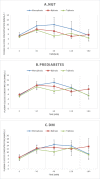The shape of the glucose response curve during an oral glucose tolerance test heralds β-cell function in a large Chinese population
- PMID: 31690291
- PMCID: PMC6833144
- DOI: 10.1186/s12902-019-0446-4
The shape of the glucose response curve during an oral glucose tolerance test heralds β-cell function in a large Chinese population
Abstract
Background: The shape of the glucose response curve during an oral glucose tolerance test (OGTT) can predict β-cell function and insulin resistance. However, there have been few studies conducted on Chinese people. Thus, we aimed to verify the usefulness of the glucose response curve in a large Chinese population.
Methods: A total of 9059 OGTT (3-h tests) were categorized into either a monophasic or a multiphasic group based on the shape of the glucose response. Homeostasis model assessments of fasting insulin resistance, the Matsuda Index, the insulinogenic index, and the disposition index were assessed by plasma glucose and serum insulin concentration obtained at fasting or during an OGTT.
Results: The shape of the OGTT glucose response curve was monophasic in 87.3% and multiphasic in 12.7% of participants. Individuals in the multiphasic group were younger compared to those in the monophasic group (38.6 ± 13.6 vs. 35.4 ± 13.5, P < 0.001). Individuals in the monophasic group had significantly higher fasting plasma glucose (FPG 5.6 ± 13.5 vs. 5.2 ± 0.6, P < 0.001), fasting insulin (FINS 14.8 ± 8.7 vs. 13.5 ± 7.9, P < 0.01), and homeostasis model assessment of insulin resistance (HOMA-IR 3.8 ± 2.6 vs. 3.1 ± 2.0, P < 0.001) and impaired β-cell function (disposition index 12.7 ± 14.1 vs. 16.6 ± 17.8, P < 0.001) compared to those in the multiphasic group.
Conclusion: The monophasic OGTT glucose response curve could reflect impaired β-cell function in a large Chinese population.
Keywords: Chinese; Glucose response curve; OGTT.
Conflict of interest statement
The authors declare that they have no competing interests.
Figures



References
MeSH terms
Substances
Grants and funding
- 91846106/National Natural Science Foundation of China
- 71432004/National Natural Science Foundation of China
- 2017PT32020/Non-profit Central Research Institute Fund of Chinese Academy of Medical Sciences
- 2018PT32001/Non-profit Central Research Institute Fund of Chinese Academy of Medical Sciences
- CIFMS2016-I2M-4-001/Chinese Academy of Medical Sciences Innovation Fund for Medical Sciences
LinkOut - more resources
Full Text Sources
Medical

